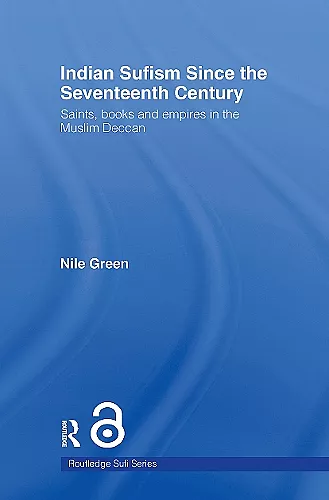Indian Sufism since the Seventeenth Century
Saints, Books and Empires in the Muslim Deccan
Format:Paperback
Publisher:Taylor & Francis Ltd
Published:3rd Aug '09
Currently unavailable, and unfortunately no date known when it will be back
This paperback is available in another edition too:
- Hardback£150.00(9780415390408)

This insightful study examines the intersection of politics and poetry in Indian Sufism, particularly focusing on its cultural context and the lives of significant Sufi saints.
Nile Green explores the intricate relationship between politics and poetry within Indian Sufism, focusing on Islamic sainthood in a diverse, cosmopolitan Indian society. This society includes various groups such as migrants, soldiers, litterateurs, and princes, all of whom contribute to the rich tapestry of cultural life. By challenging the notion that Sufism exists in isolation from its cultural context, Indian Sufism since the Seventeenth Century offers a nuanced understanding of how these mystical traditions are interwoven with the broader social fabric.
The book specifically highlights the shrines of four Sufi saints located in the often-overlooked Deccan region, examining their evolving significance under the Mughal Empire, the Nizams of Hyderabad, and later within the Indian nation post-1948. A particular focus is placed on the city of Aurangabad, which serves as a backdrop for exploring the vibrant intellectual and cultural history that has shaped this area as part of the independent state of Hyderabad. Through this lens, the text sheds light on the dynamic interplay between spirituality and socio-political changes.
Employing a blend of historical texts and anthropological fieldwork, Indian Sufism since the Seventeenth Century provides a fresh perspective on the developments of devotional Islam in South Asia over the last three centuries. This comprehensive approach enhances our understanding of Sufism and the pivotal role of Muslim saints in shaping the region's cultural landscape.
'This is an unusually accomplished first book' - Francis Robinson, Journal of the Royal Asiatic Society, Vol 17 Issue 1, 2007
"Superbly well-researched" and "splendid monograph … more than any other study to date succeeds in demolishing the notion of a dichotomy between ‘popular’ and ‘elite’ Sufism" - Richard M. Eaton, Journal of Islamic Studies, 18, 3 (2007)
"Each passage of this innovative and essential book demonstrates the mastery of an immense corpus of sources in Arabic, Persian and Urdu, and reveals an abundance of original ideas, that make us see the history of Islam in South Asia in new light." - Denis Matringe, Bulletin of the School of Oriental and African Studies, 71, 3 (2008)
"a daring effort to venture beyond the texts, both by looking at the context that produced these saints and by putting each of the texts written about these three saints and their successors into the context of their respective times... this book is well-researched and timely." - Gijs Kruijtzer, Journal of the Economic and Social History of the Orient, 51, 4 (2008)
"a wonderful study …. The literature on Sufism in India is richer and more textured as a result of this work." - Sajjad H. Rizvi, American Journal of Islamic Social Sciences, 25, 3 (2008)
"A superb study of mystical Islam within the cultural context of India’s Deccan region…. Particularly impressive is the innovative analysis of Muslim saints in the Hyderabadi city of Aurangabad that draws on a wide range of texts in Urdu, Persian and Arabic, as well as anthropological fieldwork." - Siobhan Lambert-Hurley, Annual Bulletin of Historical Literature 93, 1 (2009)
ISBN: 9780415549882
Dimensions: unknown
Weight: 440g
240 pages